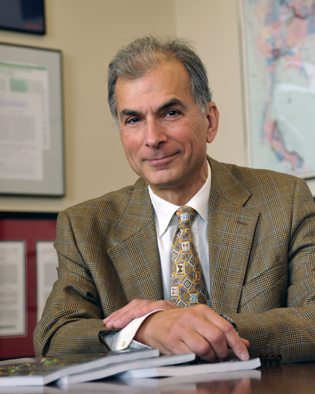Neal Young: Conquering Aplastic Anemia
Forty years ago, a diagnosis of severe aplastic anemia meant almost certain death. The bone marrow would suddenly stop producing new blood cells—red blood cells, white blood cells, and platelets. Today, however, thanks to the work of NIH scientist Neal Young and others, the survival rate for this rare disease is above 80 percent.
Young first encountered patients with severe aplastic anemia as a medical student at Johns Hopkins (Baltimore) in the 1970s. He found it especially painful to care for these patients because they were young and had previously been healthy, and there was little anyone could do for them medically.

ERNIE BRANSON
NHLBI scientist Neal Young is credited with developing an immunosuppressive regimen that has become the standard treatment for aplastic anemia.
After completing his residency, Young went to NIH to learn protein biochemistry in the laboratory of Nobel prize winner Christian Anfinsen; then went to the Barnes Hospital of Washington University School of Medicine (St. Louis) to do a fellowship in hematology; and returned to NIH for a second postdoctoral fellowship in molecular biology under Arthur Nienhuis in the National Heart, Lung, and Blood Institute (NHLBI).
In 1981, Young became a senior investigator and established an independent section to study the pathogenesis and treatment of human bone-marrow failure. He is now chief of NHLBI’s Hematology Branch and director of the trans-NIH Center for Human Immunology, Autoimmunity, and Inflammation. His outpatient department at NIH may be the largest bone-marrow-failure clinic in the world.
There’s a better understanding of what causes aplastic anemia now than when Young was in training. It’s long been linked to a diverse group of environmental factors and other associated diseases: toxins such as pesticides, arsenic, and benzene; radiation and chemotherapy; some medicines; and even some infectious diseases and autoimmune disorders. For acquired aplastic anemia, regardless of the presumed inciting cause, the immune system does the damage by destroying bone-marrow stem and progenitor cells. Depending on the severity of the disease, follow-up can range from observation, to treatment with blood transfusions and medications, to bone-marrow transplant or immunosuppressive therapy.
Young is credited with developing an immunosuppressive regimen that has become the standard treatment for aplastic anemia. Early in his career, he came across European studies that showed the immune system–suppressing biologic called antithymocyte globulin (ATG) could help. Although others were skeptical, he decided to test ATG in a clinical trial in the United States. Patients responded favorably and most became free of the need for transfusion and no longer were susceptible to serious infections. Later he added cyclosporine, a drug used to prevent the rejection of transplanted organs, and the success rate rose from 50 to 70 percent. Today, Young is testing novel therapies to increase the response rate.
In one of his current clinical trials, in collaboration with NHLBI colleagues Cynthia Dunbar and Danielle Townsley, Young is treating aplastic anemia patients with a pill—a synthetic molecule that stimulates hematopoietic stem cells in the bone marrow. He is optimistic that by combining immunosuppression and stem-cell stimulation, aplastic anemia may one day be successfully treated without resorting to bone-marrow transplants.
Young’s research started with patients but it has diverse laboratory components, too. Early on, he used flow cytometry and molecular biology methods, then new to the clinic, to characterize the aberrant immune response in aplastic anemia. He has found that many of the immune abnormalities resemble those seen with viral infection. This interest in viruses led him to examine a newly discovered virus called B19 parvovirus. B19 could cause one type of anemia due to marrow failure. He elucidated the virus’s cellular and molecular biology and developed a vaccine that is now in clinical trials.
More recently, his group discovered genetic defects in patients with aplastic anemia as well as in patients with liver cirrhosis, lung fibrosis, and leukemia. The mutated genes regulate telomere repair. Telomere loss and repair are now an important part of Young’s research focus; he is combining basic research and clinical trials to study the effects of male sex hormones, or androgens, on the length of telomeres (sequences of DNA that cap the ends of chromosomes). He’s testing whether androgen therapy can repair or at least stabilize telomeres. The clinical trial is “proof of principle that telomere repair is a drugable target,” Young noted.
Young appreciates how NIH has allowed him enormous flexibility in his research and has enjoyed training fellows who now lead groups dedicated to the study of bone-marrow failure. Most important, he said, was being able to stay close to the patients—and follow their progress for decades—who have sought out diagnosis and treatment at NIH. The sustained efforts of his laboratory and clinic have had a profound impact on the lives of those patients and many others with aplastic anemia.
To read more about Neal Young, visit https://irp.nih.gov/pi/neal-young.
This page was last updated on Thursday, April 28, 2022
